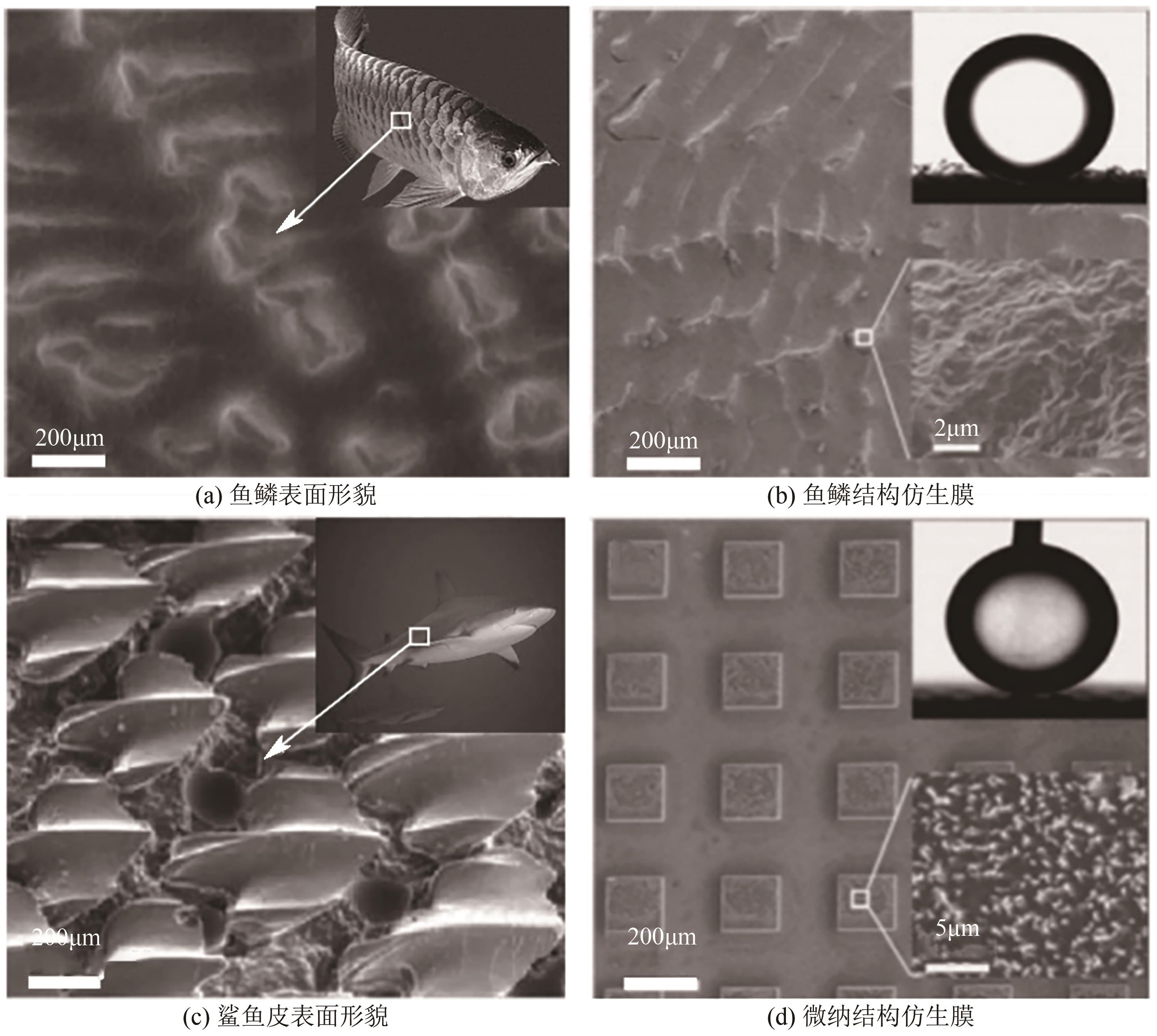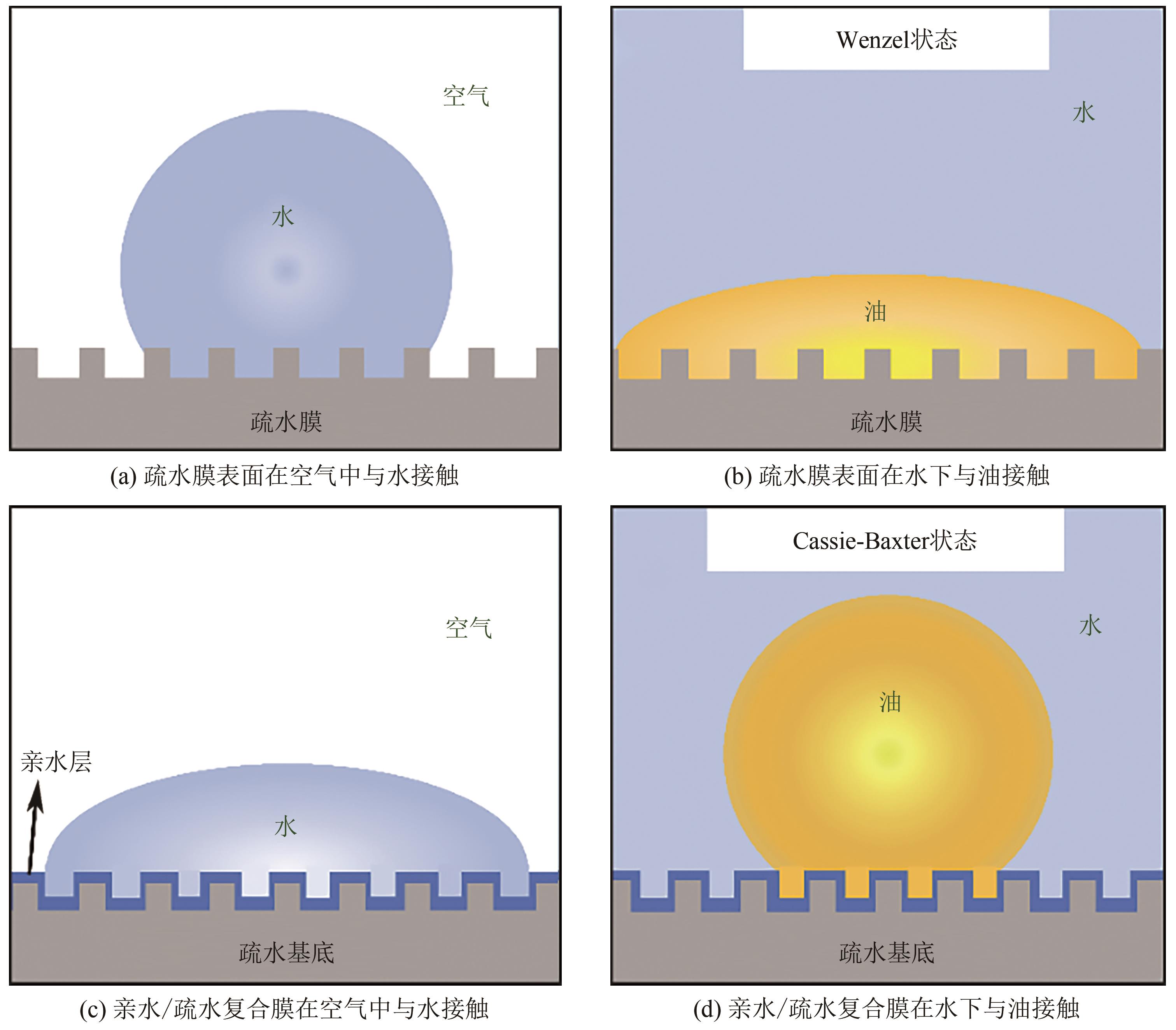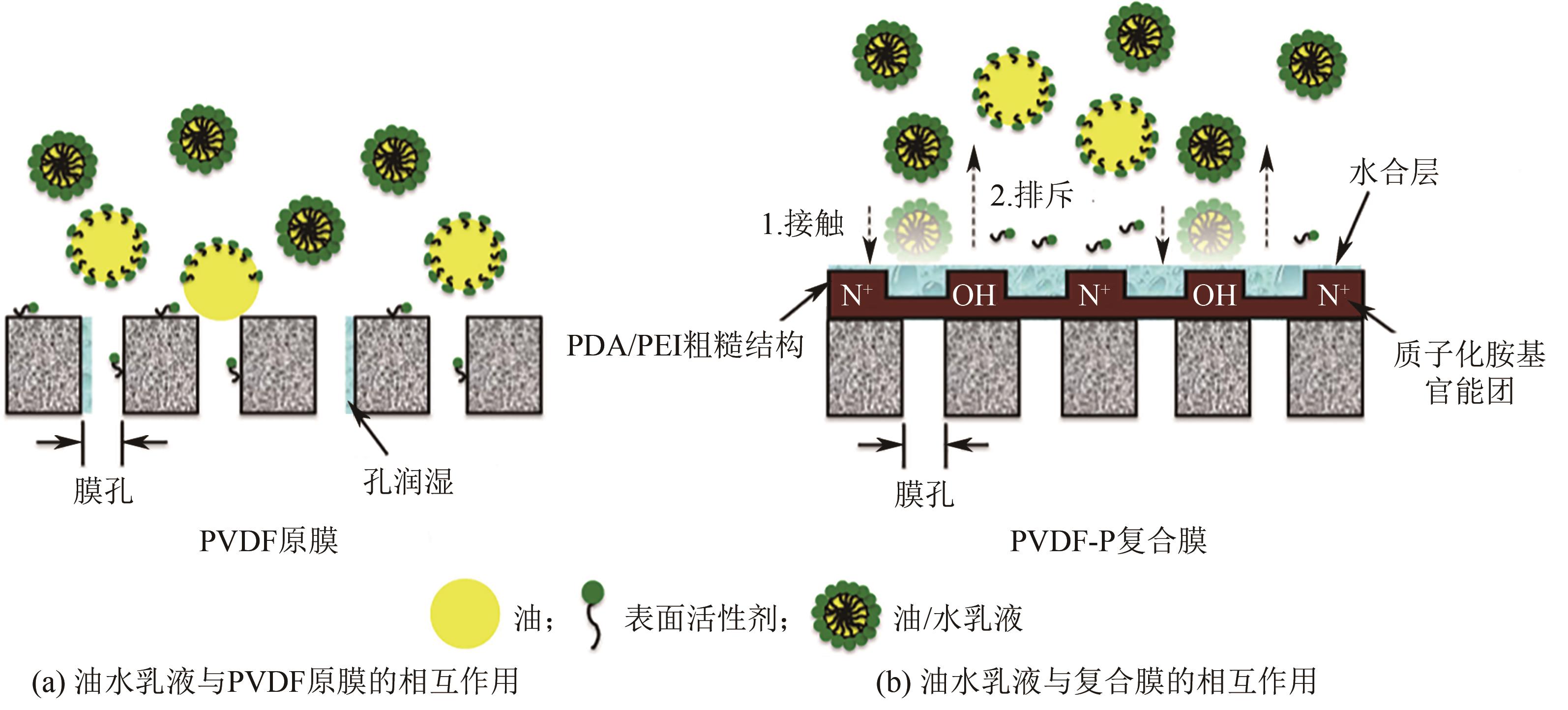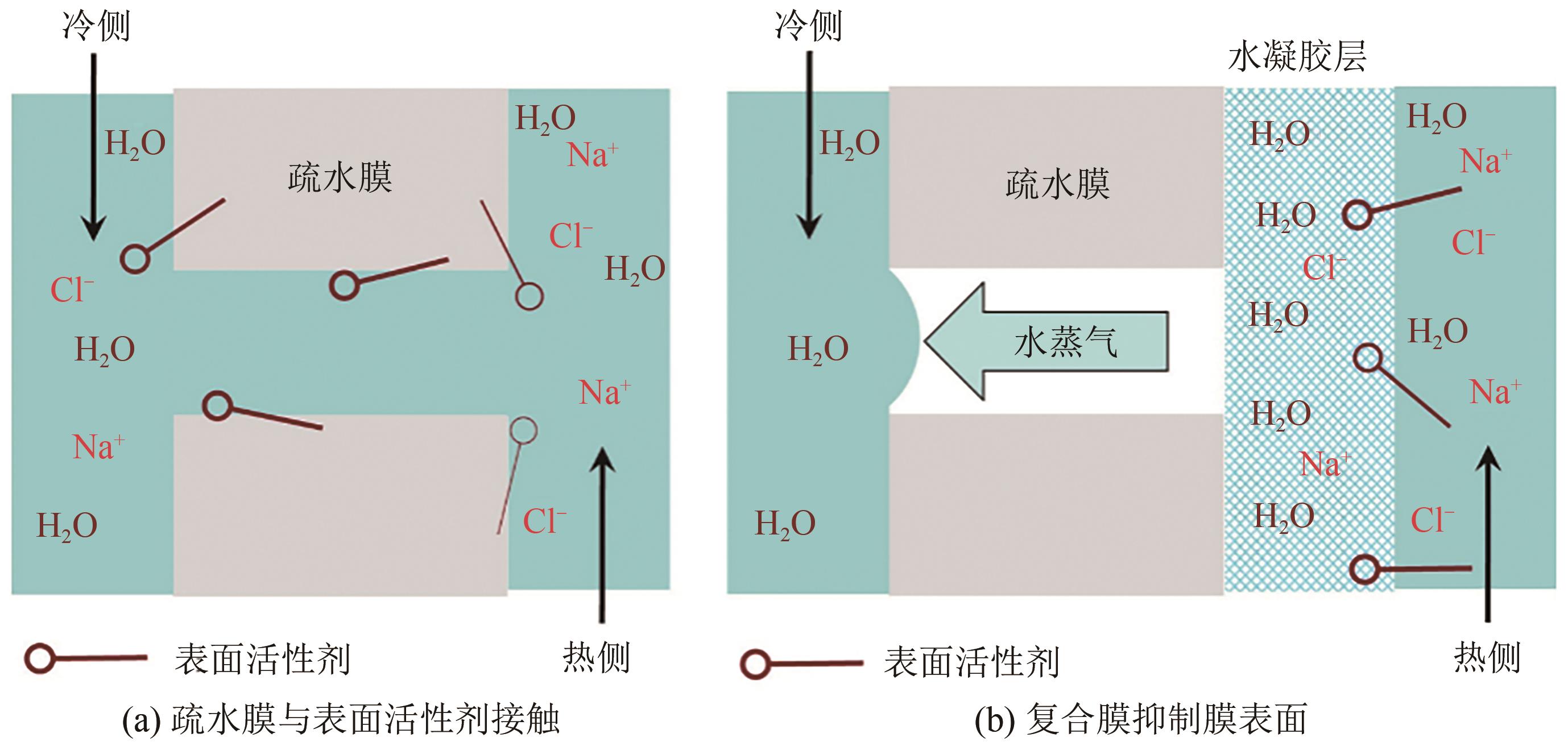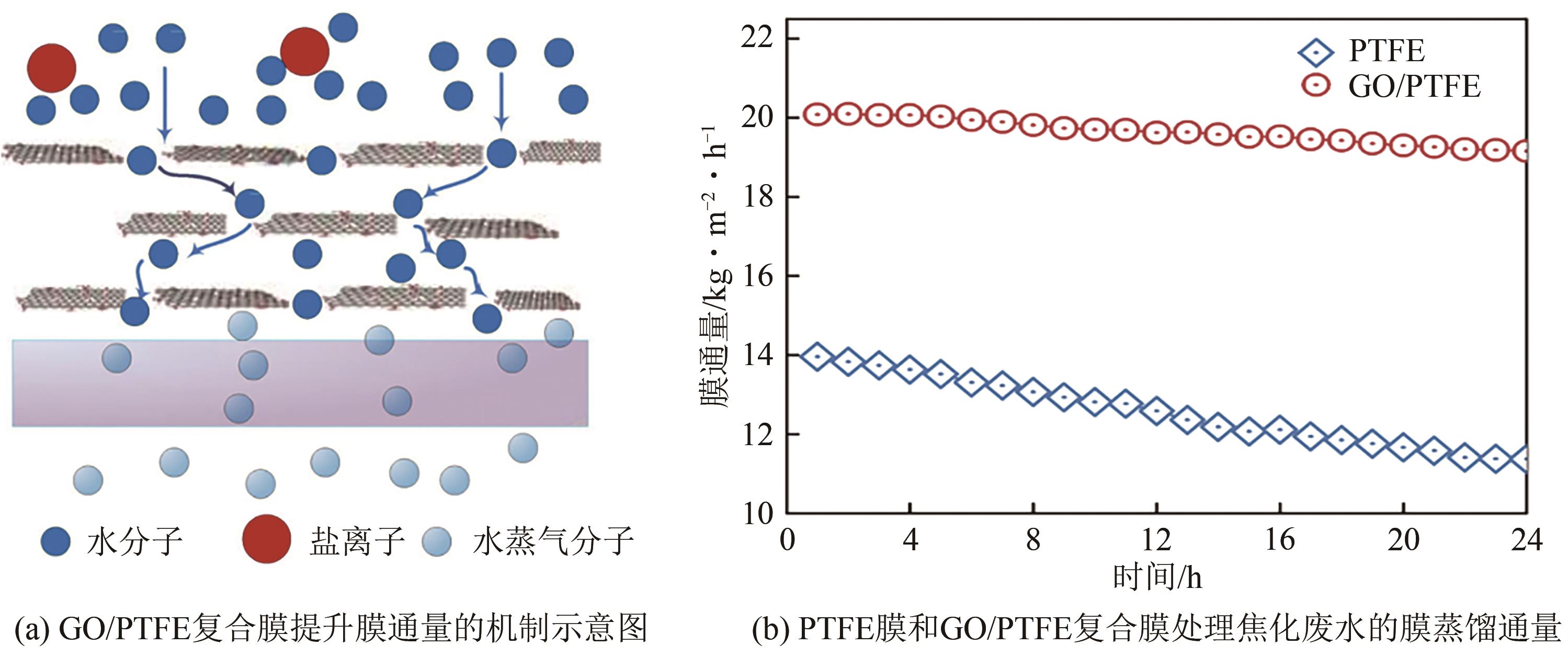化工进展 ›› 2021, Vol. 40 ›› Issue (11): 6347-6357.DOI: 10.16085/j.issn.1000-6613.2020-2389
亲水/疏水复合膜强化膜蒸馏深度处理工业废水的研究进展
- 山西大学资源与环境工程研究所,山西省黄河实验室,山西 太原 030006
-
收稿日期:2020-11-29修回日期:2021-04-10出版日期:2021-11-05发布日期:2021-11-19 -
通讯作者:李剑锋 -
作者简介:任静(1989—),女,博士,讲师,研究方向为抗污染膜制备与废水深度处理。E-mail:renjing@sxu.edu.cn 。 -
基金资助:国家重点研发计划(2019YFC0408605);山西省应用基础研究计划(201901D211126);山西省高等学校科技创新项目(2020L0017);中央引导地方科技发展专项资金项目(YDZX20191400002539)
Progresses of hydrophilic/hydrophobic composite membranes in membrane distillation for enhanced treatment of industrial wastewater
REN Jing( ), LIU Zhuang, GUO Shujuan, LI Jianfeng(
), LIU Zhuang, GUO Shujuan, LI Jianfeng( ), CHENG Fangqin
), CHENG Fangqin
- Shanxi Laboratory for Yellow River, Institute of Resources and Environmental Engineering, Shanxi University, Taiyuan 030006, Shanxi, China
-
Received:2020-11-29Revised:2021-04-10Online:2021-11-05Published:2021-11-19 -
Contact:LI Jianfeng
摘要:
工业废水中通常含有多种疏水性有机污染物及表面活性剂,传统疏水微孔膜用于膜蒸馏处理工业废水的过程中,这些污染物容易沉积在膜表面引发膜污染和膜润湿,导致膜蒸馏过程的低效甚至失败。亲水/疏水复合膜是一种表层亲水而底层疏水的非对称膜材料,可通过在膜表面形成水合层减缓污染物的吸附累积,同时保留疏水基底膜对污染物的高截留率,用于膜蒸馏过程可有效强化其处理复杂工业废水的效果。本文概述了构筑亲水/疏水复合膜的仿生学原理与表面润湿理论,介绍了复合膜常用的制备方法,重点分析了多种亲水材料改性制备的复合膜用于膜蒸馏深度处理工业废水的强化效果及强化机制,认为复合膜表面形成的亲水层可有效抑制工业废水中疏水性污染物与膜表面的疏水-疏水相互作用,减轻膜污染及膜润湿倾向,提高污染物截留效率,而氧化石墨烯等亲水物质可加速水分子通过,提升膜蒸馏产水通量。最后指出未来亲水/疏水复合膜的发展可以通过建立污染物在复合膜中的传递模型,进一步探究复合膜对工业废水处理过程的强化机制,通过优化调控复合膜结构,提升复合膜对工业废水中多种污染物的截留率和抗污染性能,实现膜蒸馏抗污染性、截留率和产水通量的同步提升,并通过开展中试研究验证复合膜用于工业废水深度处理的经济性和长期稳定性。
中图分类号:
引用本文
任静, 刘状, 郭淑娟, 李剑锋, 程芳琴. 亲水/疏水复合膜强化膜蒸馏深度处理工业废水的研究进展[J]. 化工进展, 2021, 40(11): 6347-6357.
REN Jing, LIU Zhuang, GUO Shujuan, LI Jianfeng, CHENG Fangqin. Progresses of hydrophilic/hydrophobic composite membranes in membrane distillation for enhanced treatment of industrial wastewater[J]. Chemical Industry and Engineering Progress, 2021, 40(11): 6347-6357.
| 1 | DESHMUKH A, BOO C, KARANIKOLA V, et al. Membrane distillation at the water-energy nexus: limits, opportunities, and challenges[J]. Energy & Environmental Science, 2018, 11(5): 1177-1196. |
| 2 | 郭智, 张新妙, 章晨林, 等. 膜蒸馏过程强化及优化技术研究进展[J]. 化工进展, 2016, 35(4): 981-987. |
| GUO Zhi, ZHANG Xinmiao, ZHANG Chenlin, et al. Current research and technical progress in membrane distillation process intensification and optimization[J]. Chemical Industry and Engineering Progress, 2016, 35(4): 981-987. | |
| 3 | WANG P, CHUNG T S. Recent advances in membrane distillation processes: membrane development, configuration design and application exploring[J]. Journal of Membrane Science, 2015, 474: 39-56. |
| 4 | DRIOLI E, ALI A, MACEDONIO F. Membrane distillation: recent developments and perspectives [J]. Desalination, 2015, 356: 56-84. |
| 5 | 刘羊九, 王云山, 韩吉田, 等. 膜蒸馏技术研究及应用进展[J]. 化工进展, 2018, 37(10): 3726-3736. |
| LIU Yangjiu, WANG Yunshan, HAN Jitian, et al. State-of-the-arts review of research and application progress for membrane distillation technology[J]. Chemical Industry and Engineering Progress, 2018, 37(10): 3726-3736. | |
| 6 | 孙楠, 李剑锋, 郭淑娟, 等. 膜蒸馏在废水处理中的研究现状与进展[J]. 工业用水与废水, 2018, 49(1): 7-11. |
| SUN Nan, LI Jianfeng, GUO Shujuan, et al. Research status and progress of membrane distillation applied to wastewater treatment[J]. Industrial Water & Wastewater, 2018, 49(1): 7-11. | |
| 7 | WOLDEMARIAM D, KULLAB A, FORTKAMP U, et al. Membrane distillation pilot plant trials with pharmaceutical residues and energy demand analysis[J]. Chemical Engineering Journal, 2016, 306: 471-483. |
| 8 | XU L L, WANG J, ZHANG X H, et al. Development of a novel integrated membrane system incorporated with an activated coke adsorption unit for advanced coal gasification wastewater treatment[J]. Colloids and Surfaces A: Physicochemical and Engineering Aspects, 2015, 484: 99-107. |
| 9 | 邓晨辉, 朱盈喜, 张鸿, 等. 高盐分低放射性废水膜蒸馏处理技术研究[J]. 水处理技术, 2018, 44(11): 76-79. |
| DENG Chenhui, ZHU Yingxi, ZHANG Hong, et al. Research on high salinity-low radioactive wastewater treatment by membrane distillation[J]. Technology of Water Treatment, 2018, 44(11): 76-79. | |
| 10 | 邓倩, 黄满红, 张月洋, 等. 膜蒸馏对4种染料废水的处理特性研究[J]. 水处理技术, 2019, 45(3): 55-59, 68. |
| DENG Qian, HUANG Manhong, ZHANG Yueyang, et al. Study on the treatment characteristics of four kinds dyes by membrane distillation[J]. Technology of Water Treatment, 2019, 45(3): 55-59, 68. | |
| 11 | DAMTIE M M, KIM B, WOO Y C, et al. Membrane distillation for industrial wastewater treatment: studying the effects of membrane parameters on the wetting performance[J]. Chemosphere, 2018, 206: 793-801. |
| 12 | 李建国, 李剑锋, 任静, 等. 超疏水疏油改性PVDF膜用于膜蒸馏深度处理焦化废水[J]. 水处理技术, 2018, 44(3): 58-62, 68. |
| LI Jianguo, LI Jianfeng, REN Jing, et al. Modification of PVDF membrane with superhydrophobic and oleophobic properties for advanced treatment of coking wastewater by membrane distillation[J]. Technology of Water Treatment, 2018, 44(3): 58-62, 68. | |
| 13 | LIN P J, YANG M C, LI Y L, et al. Prevention of surfactant wetting with agarose hydrogel layer for direct contact membrane distillation used in dyeing wastewater treatment[J]. Journal of Membrane Science, 2015, 475: 511-520. |
| 14 | NAIDU G, JEONG S, VIGNESWARAN S. Interaction of humic substances on fouling in membrane distillation for seawater desalination[J]. Chemical Engineering Journal, 2015, 262: 946-957. |
| 15 | SUN W S, SHEN F, WANG Z S, et al. An ultrathin, porous and in-air hydrophilic/underwater oleophobic coating simultaneously increasing the flux and antifouling property of membrane for membrane distillation[J]. Desalination, 2018, 445: 40-50. |
| 16 | WANG K P, HOU D Y, WANG J, et al. Hydrophilic surface coating on hydrophobic PTFE membrane for robust anti-oil-fouling membrane distillation[J]. Applied Surface Science, 2018, 450: 57-65. |
| 17 | HOU D Y, DING C L, LI K L, et al. A novel dual-layer composite membrane with underwater-superoleophobic/hydrophobic asymmetric wettability for robust oil-fouling resistance in membrane distillation desalination[J]. Desalination, 2018, 428: 240-249. |
| 18 | NISHIMOTO S, BHUSHAN B. Bioinspired self-cleaning surfaces with superhydrophobicity, superoleophobicity, and superhydrophilicity[J]. RSC Advances, 2013, 3(3): 671-690. |
| 19 | WANG Z X, HOU D Y, LIN S H. Composite membrane with underwater-oleophobic surface for anti-oil-fouling membrane distillation[J]. Environmental Science & Technology, 2016, 50(7): 3866-3874. |
| 20 | LIU M J, WANG S T, WEI Z X, et al. Bioinspired design of a superoleophobic and low adhesive water/solid interface[J]. Advanced Materials, 2009, 21(6): 665-669. |
| 21 | REZAEI M, WARSINGER D M, LIENHARD V J H, et al. Wetting phenomena in membrane distillation: mechanisms, reversal, and prevention[J]. Water Research, 2018, 139: 329-352. |
| 22 | JUNG Y C, BHUSHAN B. Wetting behavior of water and oil droplets in three-phase interfaces for hydrophobicity/philicity and oleophobicity/philicity[J]. Langmuir, 2009, 25(24): 14165-14173. |
| 23 | BIKERMAN J J. The surface roughness and contact angle[J]. The Journal of Physical and Colloid Chemistry, 1950, 54(5): 653-658. |
| 24 | CASSIE A B D. Contact angles[J]. Discussions of the Faraday Society, 1948, 3: 11-16. |
| 25 | ZHU Z G, LIU Y R, HOU H Q, et al. Dual-bioinspired design for constructing membranes with superhydrophobicity for direct contact membrane distillation[J]. Environmental Science & Technology, 2018, 52(5): 3027-3036. |
| 26 | LIU H, WANG Y D, HUANG J Y, et al. Bioinspired surfaces with superamphiphobic properties: concepts, synthesis, and applications[J]. Advanced Functional Materials, 2018, 28(19): 1707415. |
| 27 | WANG Z X, JIN J, HOU D Y, et al. Tailoring surface charge and wetting property for robust oil-fouling mitigation in membrane distillation[J]. Journal of Membrane Science, 2016, 516: 113-122. |
| 28 | ZUO G Z, WANG R. Novel membrane surface modification to enhance anti-oil fouling property for membrane distillation application[J]. Journal of Membrane Science, 2013, 447: 26-35. |
| 29 | WANG Z X, LIN S H. Membrane fouling and wetting in membrane distillation and their mitigation by novel membranes with special wettability[J]. Water Research, 2017, 112: 38-47. |
| 30 | SALEHI S M, DI PROFIO G, FONTANANOVA E, et al. Membrane distillation by novel hydrogel composite membranes[J]. Journal of Membrane Science, 2016, 504: 220-229. |
| 31 | HUANG Y X, WANG Z X, JIN J, et al. Novel Janus membrane for membrane distillation with simultaneous fouling and wetting resistance[J]. Environmental Science & Technology, 2017, 51(22): 13304-13310. |
| 32 | WU J, WANG N, WANG L, et al. Electrospun porous structure fibrous film with high oil adsorption capacity[J]. ACS Applied Materials & Interfaces, 2012, 4(6): 3207-3212. |
| 33 | 雷晓慧, 丁雪佳, 王林生, 等. 相转化法制备聚砜膜研究进展[J]. 中国塑料, 2013, 27(1): 13-16. |
| LEI Xiaohui, DING Xuejia, WANG Linsheng, et al. Progress in research on polysulfone membranes by phase-inversion[J]. China Plastics, 2013, 27(1): 13-16. | |
| 34 | LI H N, YANG J, XU Z K. Asymmetric surface engineering for Janus membranes[J]. Advanced Materials Interfaces, 2020, 7(7): 1902064. |
| 35 | LU K J, ZUO J, CHUNG T S. Novel PVDF membranes comprising n-butylamine functionalized graphene oxide for direct contact membrane distillation[J]. Journal of Membrane Science, 2017, 539: 34-42. |
| 36 | LI M, LU K J, WANG L J, et al. Janus membranes with asymmetric wettability via a layer-by-layer coating strategy for robust membrane distillation[J]. Journal of Membrane Science, 2020, 603: 118031. |
| 37 | 丁春立. 水下疏油/疏水复合膜制备及其在膜蒸馏过程中的应用研究[D]. 天津: 河北工业大学, 2018. |
| DING Chunli. Preraration and application of hydrophilic/hydrophobic composite membranes for membrane distillation[D]. Tianjin: Hebei University of Technology, 2018. | |
| 38 | LI J F, WU J, SUN H F, et al. Advanced treatment of biologically treated coking wastewater by membrane distillation coupled with pre-coagulation[J]. Desalination, 2016, 380: 43-51. |
| 39 | JIANG J H, ZHU L P, ZHU L J, et al. Surface characteristics of a self-polymerized dopamine coating deposited on hydrophobic polymer films[J]. Langmuir, 2011, 27(23): 14180-14187. |
| 40 | 杨皓程. 基于聚多巴胺/聚乙烯亚胺共沉积技术的聚合物膜表界面工程[D]. 杭州: 浙江大学, 2017. |
| YANG Haocheng. Surface and interface engineering of polymer membranes via polydopamine/polvethvlene-imine co-deposition[D]. Hangzhou: Zhejiang University, 2017. | |
| 41 | XU Z Z, YAN X Q, DU Z P, et al. Effect of oxygenic groups on desalination performance improvement of graphene oxide-based membrane in membrane distillation[J]. Separation and Purification Technology, 2020, 251: 117304. |
| 42 | YANG H C, ZHONG W W, HOU J W, et al. Janus hollow fiber membrane with a mussel-inspired coating on the lumen surface for direct contact membrane distillation[J]. Journal of Membrane Science, 2017, 523: 1-7. |
| 43 | CHEW N G P, ZHAO S S, MALDE C, et al. Superoleophobic surface modification for robust membrane distillation performance[J]. Journal of Membrane Science, 2017, 541: 162-173. |
| 44 | 顾瑾, 李俊俊, 孙余凭, 等. 聚乙烯醇膜的改性及应用研究进展[J]. 化工进展, 2013, 32(5): 1074-1080. |
| GU Jin, LI Junjun, SUN Yuping, et al. Progresses in the modification and application of poly(vinyl alcohol) membrane[J]. Chemical Industry and Engineering Progress, 2013, 32(5): 1074-1080. | |
| 45 | BEEBE D J, MOORE J S, BAUER J M, et al. Functional hydrogel structures for autonomous flow control inside microfluidic channels[J]. Nature, 2000, 404(6778): 588-590. |
| 46 | POLOTSKY A A, PLAMPER F A, BORISOV O V. Collapse-to-swelling transitions in pH-and thermoresponsive microgels in aqueous dispersions: the thermodynamic theory[J]. Macromolecules, 2013, 46(21): 8702-8709. |
| 47 | TIJING L D, WOO Y C, CHOI J S, et al. Fouling and its control in membrane distillation — A review[J]. Journal of Membrane Science, 2015, 475: 215-244. |
| 48 | 汪义泽, 王德武, 侯得印, 等. 亲疏水性CuBTC/PVDF复合膜应用于膜蒸馏抗油实验[J]. 化工学报, 2020, 71(6): 2811-2820. |
| WANG Yize, WANG Dewu, HOU Deyin, et al. Hydrophilic-hydrophobic CuBTC/PVDF composite membrane applied to membrane distillation anti-oil experiment[J]. CIESC Journal, 2020, 71(6): 2811-2820. | |
| 49 | REN J, LI J F, XU Z Z, et al. Simultaneous anti-fouling and flux-enhanced membrane distillation via incorporating graphene oxide on PTFE membrane for coking wastewater treatment[J]. Applied Surface Science, 2020, 531: 147349. |
| 50 | QIU H R, PENG Y L, GE L, et al. Pore channel surface modification for enhancing anti-fouling membrane distillation[J]. Applied Surface Science, 2018, 443: 217-226. |
| 51 | BOUKHVALOV D W, KATSNELSON M I, SON Y W. Origin of anomalous water permeation through graphene oxide membrane[J]. Nano Letters, 2013, 13(8): 3930-3935. |
| 52 | DREYER D R, PARK S, BIELAWSKI C W, et al. The chemistry of graphene oxide[J]. Chemical Society Reviews, 2010, 39(1): 228-240. |
| 53 | BHADRA M, ROY S, MITRA S. Desalination across a graphene oxide membrane via direct contact membrane distillation[J]. Desalination, 2016, 378: 37-43. |
| 54 | LEAPER S, ABDEL-KARIM A, FAKI B, et al. Flux-enhanced PVDF mixed matrix membranes incorporating APTS-functionalized graphene oxide for membrane distillation[J]. Journal of Membrane Science, 2018, 554: 309-323. |
| [1] | 王家庆, 宋广伟, 李强, 郭帅成, DAI Qingli. 橡胶混凝土界面改性方法及性能提升路径[J]. 化工进展, 2023, 42(S1): 328-343. |
| [2] | 张祚群, 高扬, 白超杰, 薛立新. 二次界面聚合同步反扩散原位生长ZIF-8纳米粒子制备聚酰胺混合基质反渗透(RO)膜[J]. 化工进展, 2023, 42(S1): 364-373. |
| [3] | 许春树, 姚庆达, 梁永贤, 周华龙. 共价有机框架材料功能化策略及其对Hg(Ⅱ)和Cr(Ⅵ)的吸附性能研究进展[J]. 化工进展, 2023, 42(S1): 461-478. |
| [4] | 赵景超, 谭明. 表面活性剂对电渗析减量化工业含盐废水的影响[J]. 化工进展, 2023, 42(S1): 529-535. |
| [5] | 张婷婷, 左旭乾, 田玲娣, 王世猛. 化工园区挥发性有机物排放清单及因子库构建方法[J]. 化工进展, 2023, 42(S1): 549-557. |
| [6] | 王太, 苏硕, 李晟瑞, 马小龙, 刘春涛. 交流电场中贴壁气泡的动力学行为[J]. 化工进展, 2023, 42(S1): 133-141. |
| [7] | 王鹏, 史会兵, 赵德明, 冯保林, 陈倩, 杨妲. 过渡金属催化氯代物的羰基化反应研究进展[J]. 化工进展, 2023, 42(9): 4649-4666. |
| [8] | 葛亚粉, 孙宇, 肖鹏, 刘琦, 刘波, 孙成蓥, 巩雁军. 分子筛去除VOCs的研究进展[J]. 化工进展, 2023, 42(9): 4716-4730. |
| [9] | 王晨, 白浩良, 康雪. 大功率UV-LED散热与纳米TiO2光催化酸性红26耦合系统性能[J]. 化工进展, 2023, 42(9): 4905-4916. |
| [10] | 王琦, 寇丽红, 王冠宇, 王吉坤, 刘敏, 李兰廷, 王昊. 焦化废水生物出水中可溶解性有机物的分子识别[J]. 化工进展, 2023, 42(9): 4984-4993. |
| [11] | 史天茜, 石永辉, 武新颖, 张益豪, 秦哲, 赵春霞, 路达. Fe2+对厌氧氨氧化EGSB反应器运行性能的影响[J]. 化工进展, 2023, 42(9): 5003-5010. |
| [12] | 徐杰, 夏隆博, 罗平, 邹栋, 仲兆祥. 面向膜蒸馏过程的全疏膜制备及其应用进展[J]. 化工进展, 2023, 42(8): 3943-3955. |
| [13] | 李雪佳, 李鹏, 李志霞, 晋墩尚, 郭强, 宋旭锋, 宋芃, 彭跃莲. 亲水和疏水改性膜的抗结垢和润湿能力的对比[J]. 化工进展, 2023, 42(8): 4458-4464. |
| [14] | 常印龙, 周启民, 王青月, 王文俊, 李伯耿, 刘平伟. 废弃聚烯烃的高值化学回收研究进展[J]. 化工进展, 2023, 42(8): 3965-3978. |
| [15] | 潘宜昌, 周荣飞, 邢卫红. 高效分离同碳数烃的先进微孔膜:现状与挑战[J]. 化工进展, 2023, 42(8): 3926-3942. |
| 阅读次数 | ||||||
|
全文 |
|
|||||
|
摘要 |
|
|||||
